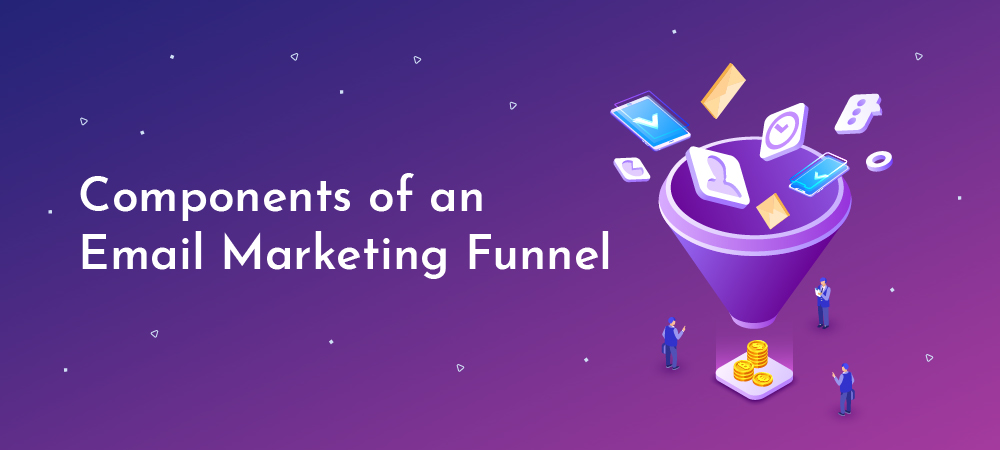It’s no secret: email is arguably the single most effective marketing tool in your arsenal. For every dollar you spend, you can usually expect $38-$44 in return, and that’s not just for email marketing experts or oddball industries, either.

If you want to tap into this mega revenue-generating machine, you’ll want to start with a quality email marketing tool that will automate much of the process for you.
Let’s dive into the specifics on what an email marketing funnel is and what you need to include in yours so you can earn some of the chart-busting ROI that other companies do.
What’s an Email Marketing Funnel?
If you feel like you need an MBA to understand what an email marketing funnel is (or any sales funnel, for that matter), rest assured you don’t. The term sounds big and scary, but really it’s just the process of how prospects move through your sales pitch.
Specifically, an email marketing funnel is designed to move your prospects through every stage of the typical buying cycle. The goals are simple: encourage them to engage with your emails, make a purchase, and build your brand.
One of the most effective ways to grow your audience is by creating email funnels for all the different products, webinars, events, and services you offer. Let’s look at how you can build up an email list and start marketing your company to your subscribers:

1. Lead Capture
To start marketing via email, you’ll need a list of people to send to. Email subscriber lists are grown in two ways: opt-in forms and landing pages.
Opt-in Forms
Also referred to as lead capture forms, opt-in forms are a direct way for subscribers to sign up to receive your emails. You can place an opt-in form on your website (commonly found in a sidebar or as a pop-up form) to get website visitors to sign up.
This way, you can still learn about the people that visit your website but don’t purchase and have an easy way to market to them and stay top of mind.
Landing Pages
Landing pages are the bigger, more powerful version of opt-in forms. Rather than have a small form on a web page, landing pages are the web page.
Each landing page is geared toward a specific action. For example, you might create a landing page to promote your e-book and ask subscribers to opt-in to receive it. Landing pages are usually more detailed than simple opt-in forms and visitors are getting something in return.
2. Welcome Email
As you start adding subscribers to your email list, the first thing they should receive from you is a welcome email. This lets the subscriber know they’ve successfully opted in and can set the tone for what to expect from your emails going forward.
Also, it gives them an opportunity to opt-out of receiving emails in case they didn’t mean to opt-in or they changed their mind. It’s better for you if they unsubscribe rather than sending your stuff to spam.
3. Nurturing emails
You work hard to earn subscribers, but your work doesn’t end once they’re on the list. Help them get used to seeing you pop up in their inbox so they can get more familiar with your brand. This helps keep the relationship from going stale and gives you a better chance of building connections.
To do this, there are three types of emails you’ll want to send: high-value content, authority-building content, and calls to action.

High-Value Content
Emails that provide value aren’t just likely to be opened — they’re also more likely to be saved. Offer something whose shelf life is greater than the time they spend on the first read-through. For example, you might provide a helpful checklist, free download, or onboarding guide they’ll want to refer back to later.
Take a look at the example above, they are offering flier miles, which is very beneficial for a frequent flier.
Authority-Building Content
Your email should help build your reputation as an expert in your industry. Send your subscribers a case study based on something you did, a client success story, industry news, or anything that helps your subscribers trust your skills and abilities. They’ll be more likely to open future emails if they feel inspired and empowered by your expertise.
Calls to Action
One of the biggest goals of email marketing is to encourage your subscribers to act. This could be to sign up for a class or webinar, make a purchase, or even join you on social media. However you’re using email marketing, make sure to include clear calls to action to drive revenue and engagement.
Maximize Your Email Marketing Funnel with LeadSquared!
Are you ready to create your first email marketing funnel or fine-tune your existing one? LeadSquared makes it easy to get started!
Our lead gen tools help you do more with every lead you get and nurtures them every step of the way. This way, you can see at a glance which leads give you the best chance of a conversion. And for those that aren’t ready to buy, your email marketing funnel will continue growing the relationship until they make a decision.
Try LeadSquared free for 15 days and start putting the power of email marketing to work for you!









